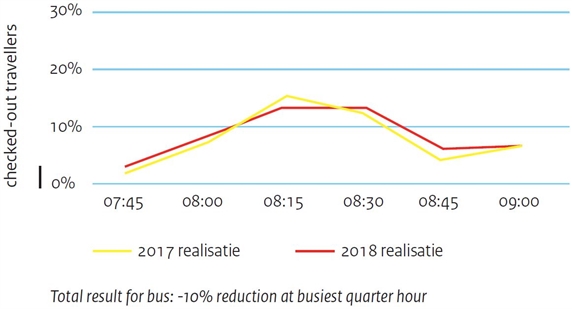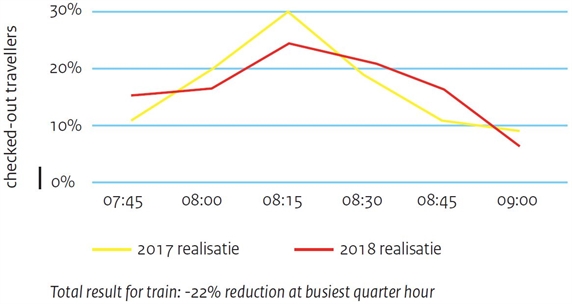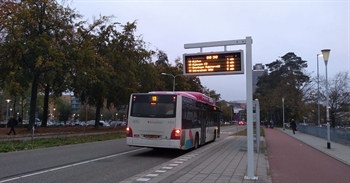Case study Smart Timetabling at the Heijendaal Campus in Nijmegen
Starting at the 2018-2019 academic year, timetables at the Heijendaal Campus in Nijmegen were modified to better spread rush-hour crowding. At Arnhem Nijmegen University of Applied Sciences (HAN) the first lessons now start at 9.00 a.m., while lectures at Radboud University now begin at 8.30 a.m. Previously, the campus-based universities both started at 8.45. By adjusting the timetables by a quarter of an hour and thus spreading the rush-hour, crowding in public transport connections to the campus has decreased.
There used to be a great deal of crowding around the Heijendaal Campus, particularly in the morning rush-hour. The campus-based MBO vocational college, university of applied science, university, and teaching hospital ensure a large influx of students. For years there was overcapacity in public transport, which made travelling to the campus uncomfortable and uncertain. The busses and trains were overcrowded and there was a real risk that you might not get on. Moreover, annual growth in the number of students and an increasing number of public transport users (partly due to the introduction of a public transport student card for all MBO students) added to the problem. The problem was greater not just for the students, but also for others who live or work in the area.
In mid-2016, the Municipality of Nijmegen, the Ministry of Infrastructure and Water Management, Radboud UMC, transport companies and educational institutions in the Duurzaam Bereikbaar Heijendaal (Sustainably Accessible Heijendaal) Project Group started an investigation into promising measures to reduce rush-hour crowding. In order to reduce pressure on public transport to the campus, four possible solutions were explored: smart timetabling, travelling by a different modality, distance learning and moving location. In the end, smart timetabling came out as the most promising solution.
After extensive research into the use of public transport and the starting times of lectures, and in close co-operation with stakeholders on campus, the starting times of HAN and Radboud University were adjusted. From then on, HAN would start at 9.00 a.m., a quarter of an hour later than before. Radboud University would start just a quarter of an hour earlier: at 8.30 a.m. ROC continued to start at 8.30 as analyses showed that they did not have to change their timetable.
Implementation
So this was not about avoiding the rush-hour but spreading the rush-hour. The aim was to reduce the hyper-rush-hour (the busiest point of the rush-hour) between 8.15 and 8.45, just before the start of the first lesson.
The actual adjustment of the timetables was preceded by an extensive process, partly because of different political and administrative interests. An opportunity analysis was carried out in which data from transport organisations were compared with data from the educational institutions. There was also a transport effects analysis in which a large-scale survey was conducted among students, and an exploration of the internal consequences of timetabling differently and the feasibility of this for the educational institutions. This in-depth study was of great importance because the aim was to use the measure on a permanent basis and also to achieve a structural effect.
The educational institutions, Radboud UMC, the transport organisations and the Ministry of Infrastructure and Water Management municipality worked closely together throughout the process. The entire process, from research to co-ordination and implementation, ultimately lasted about two years.
Results
The smart timetabling measure has had a proven effect. The rush-hour is spread better. There is no overcrowding on buses and trains. An after-measurement showed that in the busiest quarter of an hour, crowding in the train had been reduced by 22%. This is an even better result than was expected beforehand. Crowding in the campus shuttle bus (in the busiest quarter of an hour) decreased by 10%.

Due to the adjustment of the timetable, there is no longer any question of a 'hyper-rush-hour'. There is still a rush-hour, but it is better spread and therefore less extreme. However, the rush-hour does last longer than before. Due to the spread, travelling towards the campus has become more comfortable and safer. Moreover, the public transport facilities are more reliable: there is zero chance that you will be left standing on the platform because the train is full. A large result was achieved with relatively small adjustments in timetables.

Considerations for deployment elsewhere
Smart timetabling offers opportunities for deployment elsewhere. When applied elsewhere, it is important to consider the following points:
- Work together. Adjusting timetables must be tailored, which is why co-operation with the various parties involved is essential. This requires time, among other things, to build trust and to achieve good co-operation.
- Not too much at once. Suddenly making extreme changes in the timetable is unrealistic. A change in culture is needed. So think in terms of small, manageable steps, such as in this case a change of fifteen minutes.
- Think about the cost. It is difficult to put a price tag on such a measure. Although a timetable change itself does not involve a lot of costs, the process around it does require a lot of man-hours and therefore costs. Examples of this include maintaining a project group, cost of communication, tools for implementing system changes, and expenses of research and advice.
- Stay realistic and thoroughly investigate the possibilities and impossibilities. Because you want to bring about a structural change, extensive research is very important. Take your time and do not think in terms of temporary 'pilot schemes', but rather of permanent solutions with a lasting effect. Also realise that research may show that an intended solution does not (sufficiently) solve the problem and that implementation will therefore not proceed. Communicate openly about this with those involved.
- Keep the target group in view. Not all measures work for every target group. For students, changing policy (push factors) has a major impact.
- Continue to monitor the situation. The number of students, and therefore public transport travellers, is expected to continue to increase. Keep lines of communication in the area short and regularly check together whether the 'smart timetabling' measure still has the desired effect.

